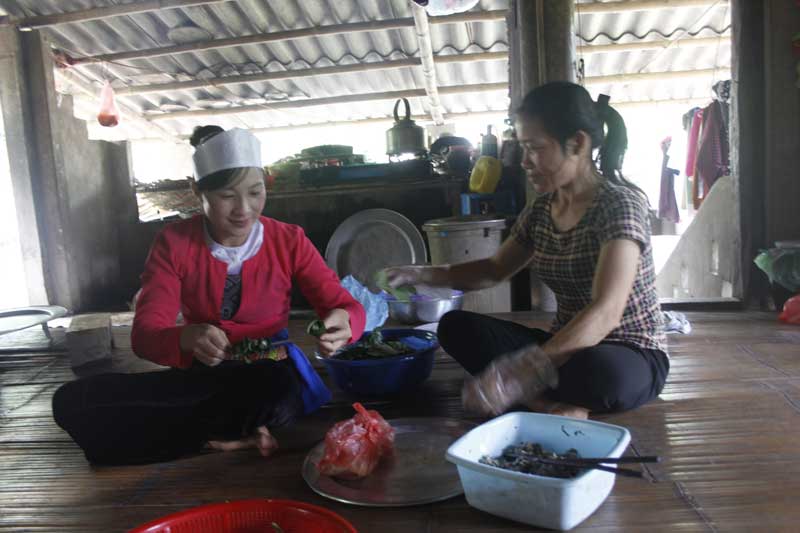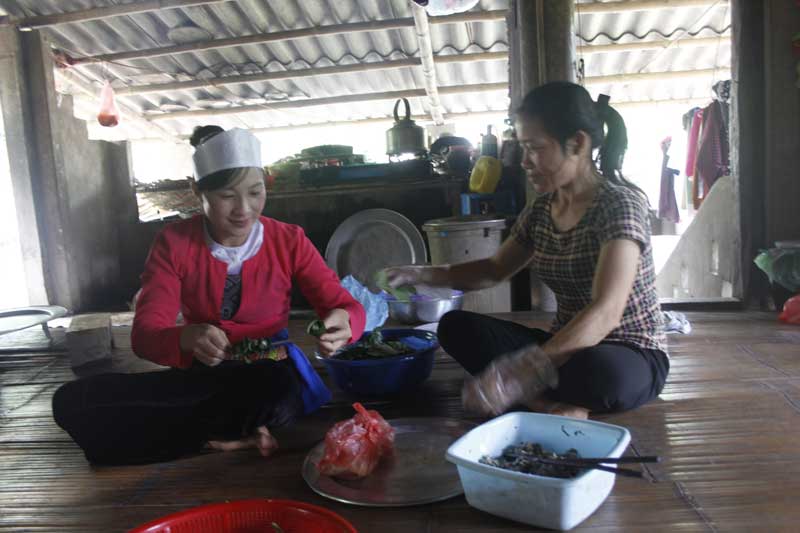
(HBO) – We visited the family of Bui Thi Su in Ai hamlet, Phong Phu commune, Tan Lac district, Hoa Binh province on a day when they were serving a group of 26 French tourists. The visitors came here from Hanoi and had lunch at Su’s house. As scheduled, they would visit Mai Chau after lunch and leave for Thanh Hoa province. Su cooked tofu with tomato sauce and wrapped betel leaves with pork for the guests while her daughter cleaned the house.
Ms. Bui Thi Su is preparing food for tourists.
Su said "Some foreign tourists just like simple
food such as roasted meat, tofu, stir-fried and boiled vegetables. Only few
want to taste traditional dishes of Muong ethnic people. In the past, when Ai
hamlet had not planned to build a community-based tourism village, my family
worked on a farm. The whole family earned a living through rice and crop cultivation
and forestry. In free time, we had to do other jobs to increase income. Thanks
to the State support, my family borrowed loans to upgrade our house, rearrange
cages for buffalos, cows and pigs, and build a toilet”.
Currently, on average, each month, Su’s family
welcomes 5-10 tourist groups. Apart from collecting 160,000 VND from each guest
who stays in her house one day with breakfast and dinner, her family also earns
money from raising cattle and growing vegetables. Excluding expenses, her
family rakes in 4-5 million VND each month. In days without guests, Su and her
spouse could do farming to improve their living.
Ai hamlet has 94 households with over 400
people. In 2016, it was recognised as a community tourism destination with over
50 traditional stilt houses in Muong ancient village.
At present, there are two households in the
hamlet doing community-based tourism. The hamlet could provide a wide range of
services for around 40 foreign tourists or 70 domestic ones such as joining art
performances, learning cooking, experiencing the daily life of locals, fishing,
growing rice, gardening, walking, and cycling./.
With an increasingly vibrant and widespread emulation movement aimed at building cultured residential areas and cultured families, Yen Thuy District has been making steady progress toward improving both the material and spiritual well-being of its people, while fostering a civilized, prosperous, beautiful, and progressive community.
Once lacking recreational spaces and community facilities, Residential Group 2 in Quynh Lam Ward (Hoa Binh City) has recently received attention for the construction of a new, spacious, and fully equipped cultural house. The project followed the model of state support combined with public contributions in both labor and funding.
The "All people unite to build cultural life" movement, which has been effectively integrated with Kim Boi district’s socio-economic development goals, is fostering a lively spirit of emulation across local residential areas, hamlets, villages, public agencies, and enterprises. In addition, through the initiative, traditional cultural values are being preserved and promoted, while community solidarity and mutual support in poverty reduction and economic development are being strengthened.
A working delegation of the Hoa Binh provincial People’s Committee led by its Permanent Vice Chairman Nguyen Van Toan on June 11 inspected the progress of a project to build the Mo Muong Cultural Heritage Conservation Space linked to tourism services in Hop Phong commune, Cao Phong district.
Born and growing in the heroic land of Muong Dong, Dinh Thi Kieu Dung, a resident in Bo town of Kim Boi district, in her childhood was nurtured by the sweet lullabies of her grandmother and mother. These melodies deeply imprinted on her soul, becoming an inseparable part of her love for her ethnic group's culture. For over 20 years, this love for her hometown has driven Dung to research, collect, and pass down the cultural values of the Muong people to future generations.
In the final days of May, the Ethnic Art Troupe of Hoa Binh Province organized performances to serve the people in remote, mountainous, and particularly disadvantaged areas within the province. These were not just ordinary artistic shows, but they were the meaningful journeys aimed at spreading cultural values, enhancing the spiritual life of the people and contributing to the preservation of ethnic minority cultural identities.



